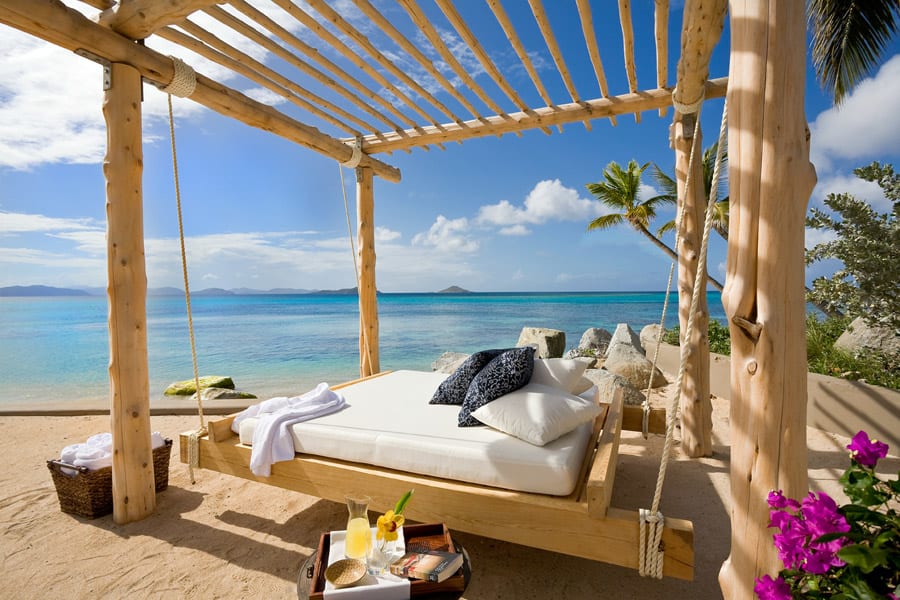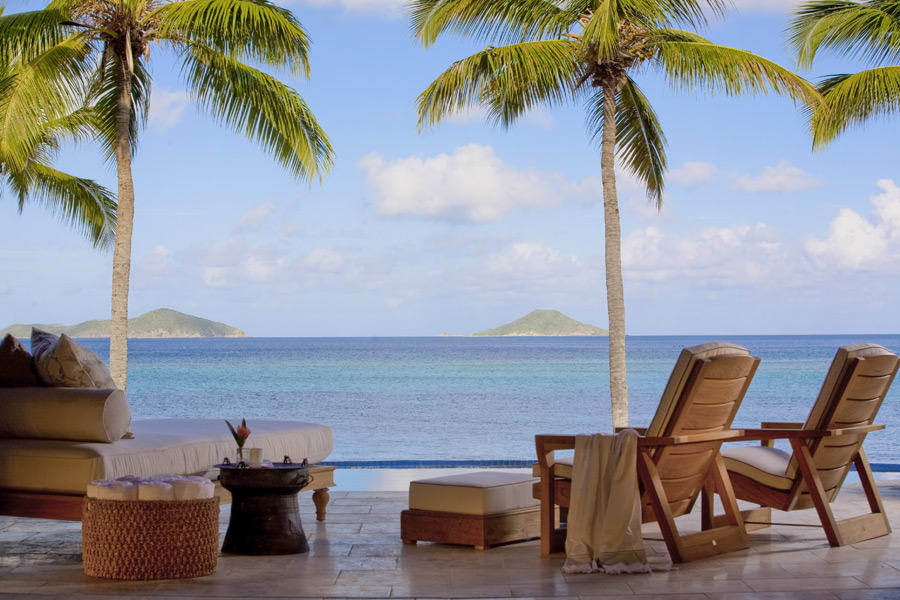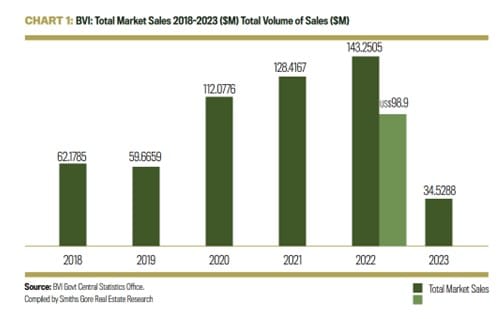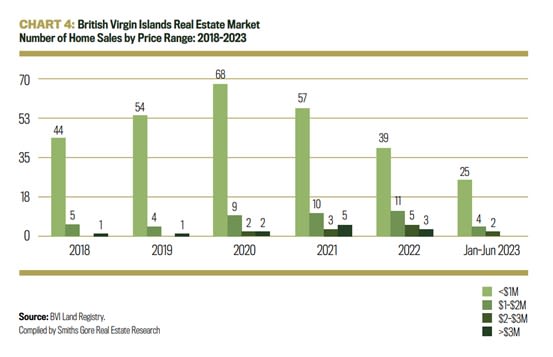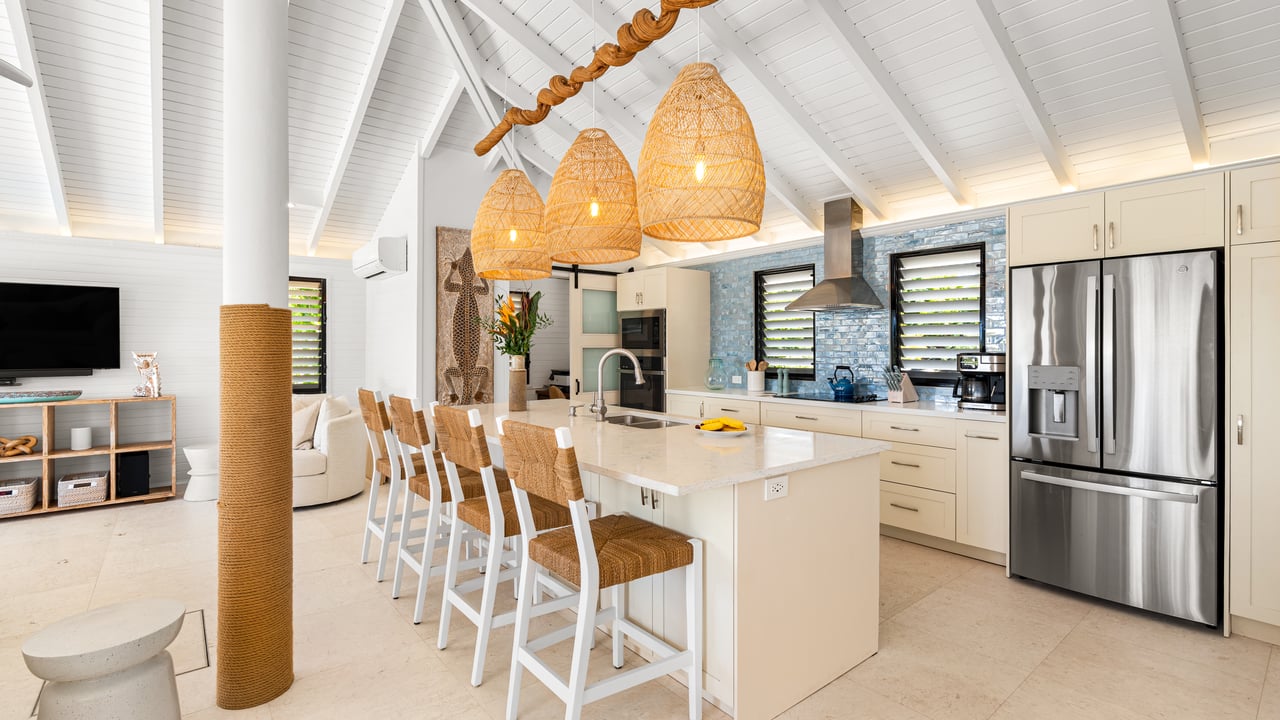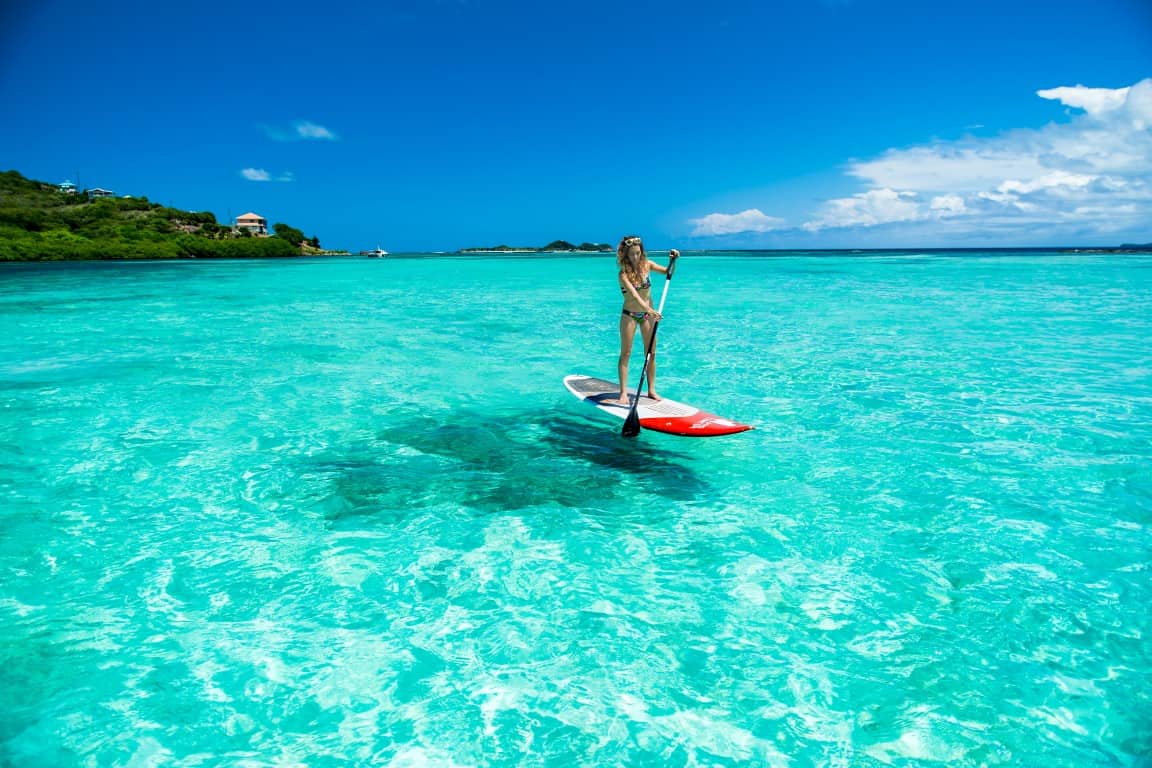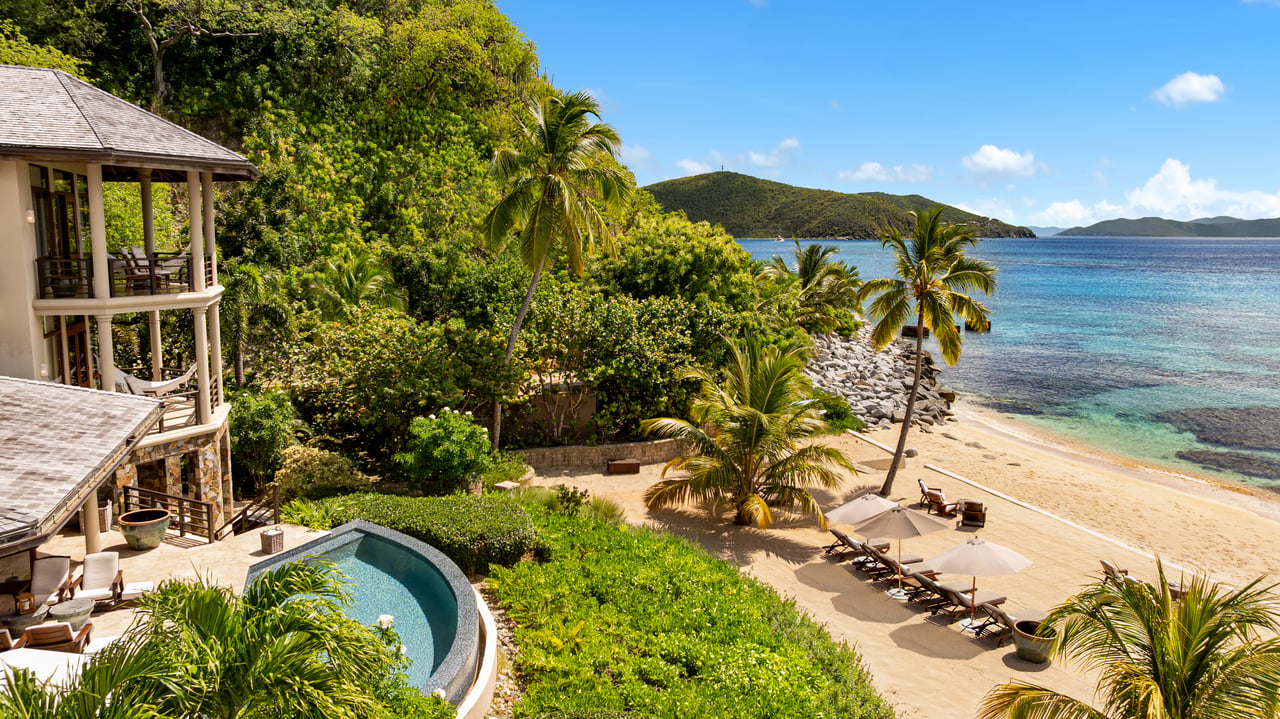BVI REAL ESTATE MARKET REVIEW
Taking a high-level view of the real estate market, there has been considerable activity in the market post Hurricane Irma and after pandemic, when the BVI Government provided a stamp duty waiver to Belongers acquiring property between May 2020 and December 2021, after which it was limited to first time Belonger purchasers. While it is a cause for celebration, that so many BV Islanders and Belongers have taken the opportunity to invest in real estate, it has been noticeable that there has not been a significant increase in foreign investment, in the BVI at a time when other Caribbean jurisdictions witnessed record real estate markets in 2021 and 2022. As mentioned above, the National Sustainable Development Plan has commented on the general lack of direct foreign investment in the BVI, particularly in the tourism sector where new developments over the past 30 years have been very limited. With the Government facing an uncertain future with respect to revenues generated from the financial sector, it has to pivot to other sectors of the economy to fill any shortfall in revenues whether in tourism, construction or through stamp duty tax generation. In the last edition of Outlook for the Real Estate Sector, we commented on the then Government’s interpretation of breaches of landholding licences, which resulted in substantial penalties being imposed on some vendors. This, along with delays in the processing of landholding licences, has created uncertainty in the market at a time when the real estate market in the United States is starting to contract. There have been several instances where purchasers have withdrawn from contracts to acquire property in the BVI as a result of these delays.
.
The new Ministry of Environment, Natural Resources and Climate Change has responsibility for the processing of non-Belonger landholding licences and we understand is looking into these issues with, hopefully, stakeholder meetings to obtain feedback from real estate and legal practitioners. While the slowdown in the processingof landholding licences and new interpretations about breaches of landholding licences are certainly problematic and need to be addressed, the underlying reasons for a historic lack of foreign investment in the BVI, whether by developers looking to undertake new resort construction or by private investors seeking to acquire a home, need to be addressed. In a small island economy, it is natural for Government to impose restrictions on foreign investment, to ensure it is in line with policy and investment goals and the landholding licence system provides a very effective regulatory tool. However, the tendency has been to expand restrictive policies, which have discouraged inward investment in areas where the Government has a stated desire to see growth, such as the construction of additional hotel rooms and other visitor accommodations. In previous editions of the Outlook for the Real Estate Sector, we have also summarised three acts which the Government has introduced : BVI Investment Act (2021), BVI Business Licence Act (still to be assented to) and the Trade Commission Act, which is now under review by the new minister of trade.
.
While the policy for the BVI Investment Act has yet to be developed, and there remain unknowns particularly with the threshold of investment, this Act and the Business Licence Act could have a significant impact on the way investment is controlled in the BVI. At the mid year BVIYHTA stakeholder meetings, local businessman and property developer Colin O’Neal gave a presentation on developing in the BVI and a plea for a BVI trade and investment body to be established to encourage investment for both BV Islanders and foreign investors alike. We would certainly encourage the Government to revisit the Investment Act and Business Licence Act, both of which will be heavy on administration, unlikely in current form to provide new incentives for foreign investment, and support Mr. O’Neal’s call for a trade and investment body similar to those established elsewhere in the Caribbean
.
.
All Property Transactions 2018 to June 2023 Chart 1 provides an overview of all real estate transactions in the BVI which show how the market increased post Hurricane Irma in 2017, with the total number of transactions increasing by 98% between 2018 and 2021 before falling by 30% in 2022. This trend continued in 2023 with a total of 84 transactions recorded by June compared to 128 through June 2022, a fall of 34% in total transactions over this six month period. The trend in the volume of sales measured by total dollar value followed a similar pattern, with sales increasing by 106% between 2018 and 2021, a reflection of the policy put in place by the Government to waive stamp duty for Belonger purchasers until the end of 2021. A fall of 23% in the volume of sales would have occurred in 2022 had it not been for a single land sale at Oil Nut Bay of $44.3M, which increased total volume of sales by 12% instead. Sales volume in 2023 in the first six months fell by 65% compared to 2022 although it included the single lot sale at Oil Nut Bay of $44.3M in May 2022. If that sale is excluded, total sales in the first six months of 2023 fell by 37%
.
Sale of Lots and Homes to Belongers and Non-Belongers 2018 to June 2023 Chart 2 summarises the sale of land and homes in the BVI to Belongers and Non-Belongers between 2018 and June 2023. The data indicates that the market has been dominated by sales to Belongers and BVI Islanders, who have predominantly been purchasing land (70% of sales to Belongers) while sales to Non-Belongers have predominantly been of homes (65% of sales to Non-Belongers). For the combined lot and home market, Belongers have accounted for 85% of all transactions between 2018 and June 2023 and 44% by sales volume ($). The lower share of sales volume ($) reflects the preponderance of lot sales to Belongers at a lower sales point and also the single lot sale at ONB at $44.3M, which significantly increased the total investment by Non-Belongers during this period. If this sale was excluded, Belongers would have 49% of the market by sales volume ($). As with the total sales chart, the market peaked in 2021. Once the stamp duty waiver programme was terminated, except for first time Belonger purchasers, a 38% fall in transactions for Belongers between 2021 and 2022 was recordrd. In contrast, there was a57% increase in sales to Non-Belongers in this period, reflecting the general improvement in market conditions elsewhere in the Caribbean, albeit the total number of sales to Non[1]Belongers only increased from 23 sales in 2021 to 36 sales in 2022.
.
.
Potential Stamp Duty Revenues for the BVI Government The direct impact of the real estate market to the Government is through the generation of stamp duty when property is sold. Current stamp duty rates are 4% of the sale price (or valuation whichever is the higher) for Belongers and 12% for Non-Belongers. Chart 3 summarises the average stamp duty per sale transaction for Belongers and Non-Belongers between 2018 and June 2023, on the basis that each transaction attracts stamp duty at the rates above (and ignoring the stamp duty waiver programme). It is evident from the Chart, that the stamp duty generated by Non-Belongers at 12% is significantly higher than the stamp duty from Belongers at 4%. It is also because Non Belongers are predominantly acquiring homes with a higher selling point than lots which form the bulk of sales to Belongers.
.
Analysis of the sales of lots and homes between 2018 to June 2023 shows that the average stamp duty generated per transaction to a Belonger is $9,260 per compared to $164,779 per transaction to a Non-Belonger. Apart from the direct tax being generated through stamp duty, the real estate market has a number of positive indirect impacts on the economy, primarily through investment through construction, employment and generation of hotel accommodation tax on short term rentals. The villa market is also an important part of the tourism sector, providing an alternative to the expansion of hotel rooms, with each rental contributing to the circulation of money in the economy through car rentals, restaurants and bars, supermarkets, booking of day excursions and other businesses associated with the tourism industry.
.

Home Sales by Price Range Chart 4 shows the distribution of home sales by price range between 2018 and June 2023. Over 80% of the market for homes in the BVI is dominated by sales under $1.0M while home sales over $2M account for just under 7% of the market. As we move away from the sale of damaged homes post Hurricane Irma, there should be evidence that the market for houses over $1.0M is starting to take a larger share. There were a total of 166 homes sold under $1.0M between 2018 and 2022 reducing to 121 between 2021 and June 2023. Belongers acquired 81% of the homes sold under $1.0M and 40% of homes sold between $1.0M and $2.0M. They also accounted for 29% of sales over $2.0M, which demonstrates investment is made by local purchasers across all price ranges in the BVI, although the level of investment falls significantly between $1.0M to $1.5M. While Non-Belongers only account for 27% of all homes sold in the BVI after 2018, they account for 71% of the home market over $2.0M. Given the number of homes on the market in the BVI over $2.0M, foreign investment is integral to the sale of higher end property market. The lack of foreign investment impacts the higher end market for homes, where properties tend to remain on the market for longer and there is a greater differential between original asking price and eventual sale price.
.
.
Where have Sales Occurred? Tracking the location of property sales in the BVI indicates that the majority of both home and lot sales have occurred on Tortola, which has accounted for 73% of home sales and 85% of lot sales between 2018 and June 2023 as shown in Chart 5.
.
Virgin Gorda accounts for just 10% of lots sold over the same period but 22% of homes sold. The sister islands account for 5% of lot and homes sales between 2018 and June 2023. In contrast, the value of transactions indicates that Virgin Gorda accounts for 35% of total homes sales and 72% of total lot sales. Excluding the single lot sale of $44.3M at Oil Nut Bay, Virgin Gorda still accounts for 64% of total lot sales by value. The data shows that Virgin Gorda remains a higher value market compared to Tortola. Excluding the single lot sale at Oil Nut Bay, the average lot sale on Virgin Gorda is $1.46M per transaction compared to $89,000 on Tortola. This reflects the sale of lots at developments including Moskito Island, Little Dix Bay as well as Oil Nut Bay which are all located within the Virgin Gorda market. Similarly, the sale of homes on Virgin Gorda averages $1.17M per transaction compared to $619,000 on Tortola.
.
Listing of Homes in the BVI July 2023 Tracking property listings for homes within the BVI, provide sellers with a better understanding of the competitive set when considering placing their property on the market. Understanding how many properties are for sale within a particular price band and in which island locations, enables sellers to appreciate the choice that a purchaser may have when contemplating a purchase. Chart 6 shows the distribution of homes listed for sale in the BVI by price range and location. As at June 2023, there are 179 homes for sale in the BVI, with 109 for sale on Tortola, 41 on Virgin Gorda and 29 on other islands. There is a marked difference between Tortola and Virgin Gorda in the distribution of listings between price bands. On Tortola 73% of all listings are below $2.0M compared to just 15% on Virgin Gorda, whereas 54% of listings on Virgin Gorda are over $3M compared to just 11% on Tortola.
.
What is evident from the data, is just 5% of all listings are for homes under $500,000, which indicate that there is limited inventory available for first time purchasers who may have limited capital and access to financing. The recently completed Joes Hill residential development project, undertaken by the BVI Social Security Board comprises 52 residential units which are aimed at first time purchasers who need to be BV Islanders or Belongers. With pricing starting at $275,900 for a one bedroom condo and ranging up to $625,000 for a three bedroom townhome, it was recently reported in the press that only four sales are currently proceeding within the development, with high purchasing costs and the inability to meet bank lending requirements being an impediment to some potential purchasers being able to proceed. The national budget estimates for 2024 included funding for the acquisition of this development by the government.
.
Listing v Sale Price Differential Understanding the time properties remain on the market and the price differential between the listing price and the eventual sale price, also assists sellers when placing a property on the market. Unlike more active markets elsewhere in the Caribbean, the BVI consistently has a significant inventory of homes for sale and a relatively small pool of purchasers, which diminishes significantly at higher prices. We typically expect to see houses which are listed at higher prices remain longer on the market and to experience a larger differential between asking price and eventual sale price than homes listed for sale below $1M. Chart 7 shows the differential between initial listing price and eventual sale price by price range for a selection of approximately sixty villas sold on Tortola and Virgin Gorda between 2021 and 2023.
.
.
There is a similar pattern on both Tortola and Virgin Gorda where the differential between initial listing price and eventual sale price increases in higher price bands. In many instances, sellers will have reduced their listing price until it was more in line with market expectations. The average time for a home on the market in this data set on Tortola was 5.5 years, compared to 3.5 years on Virgin Gorda. As with the price differential data in Chart 7, the time on the market generally increased in higher price bands.
.
The data demonstrates that many sellers opt to list their properties at unrealistic asking prices before eventually reducing the price and finding a purchaser. This process can take a number of years before a seller eventually aligns with market expectations. Reducing the available inventory, by making the purchasing process quicker, and easier, for foreign investors to acquire property in the BVI will help to reduce the time it takes to sell property and reduce the differential between asking and eventual sale prices.
.
As we move into 2024, there is much to reflect on and to look forward to. While the BVI general election did not present the change in direction that many had expected, the election itself demonstrated what is best in the BVI; a population that is able to determine its political leaders through an undisputed democratic process, where those able to vote can do so without fear or favour. Now the dust has settled, politicians are engaging with the public to hear about concerns in the private sector. It remains to be seen what actions may be taken, but few dispute that the underlying infrastructure in the BVI urgently needs concentrated attention.
